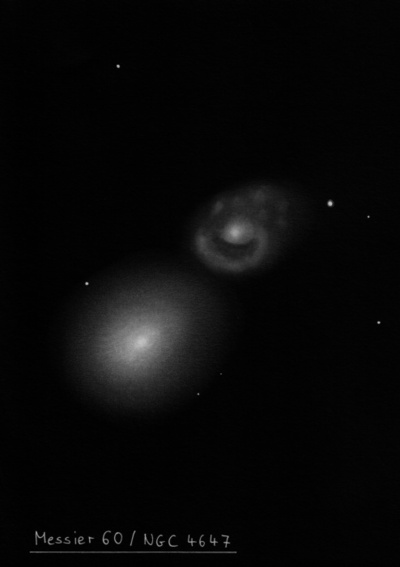
Johann Koehler discovered M60 and M59 on 11 Apr 1779 and noted "Two very small nebulae, hardly visible in a 3-foot telescope: The one above the other." Koehler was tracking the comet of that year. Oriani independently discovered M60 on 12 Apr 1779, noting "Very pale and looking exactly like the comet." Also, Messier made an independent discovery on 15 Apr 1779 (along with M58 and M59).
William Herschel first recorded M60 on 15 Mar 1784 (sweep 174) as "Two nebula [with NGC 4647], one of them vB." John Herschel's first observation was on 11 Apr 1825 (sweep 3). He logged, "A most curious double nebula. The center dist 1/6 of the field or about 3'. They join with very faint nebulosity."
300/350mm - 13.1" (5/14/83): bright, very bright nucleus, slightly elongated ~E-W.
400/500mm - 17.5" (4/25/87): very bright, fairly large, diffuse halo, slightly elongated ~E-W, very bright core with a bright substellar nucleus. Forms a double system with NGC 4647 which is almost tangent to M60 barely off the NW edge.
900/1200mm - 48" (4/19/17): at 697x; M60 and NGC 4647 were viewed but my main target was UCD 1, the brightest ultra-compact dwarf in M60. It appeared as a very faint, possibly "soft" star, just visible continuously with averted vision, and situated 1.4' SW of the center of M60. The UCD forms a wide pair with a slightly brighter mag 16.5 star 0.5' NW. CGCG 071-018 lies 6' SE of M60 and was logged as fairly faint (V = 15.5), moderately large, very elongated 3:1 E-W, 0.6'x0.2', fairly even low surface brightness.
Notes by Steve Gottlieb